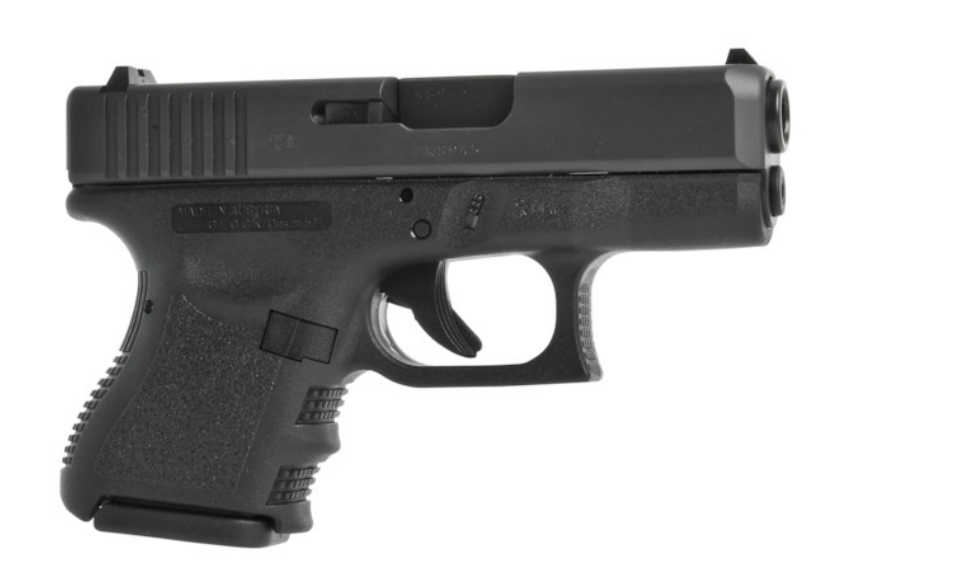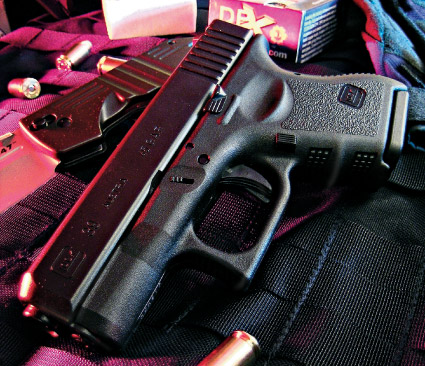Glock makes an array of pistols to fill every niche. From 9mm to .357SIG and .45ACP, in models ranging from full and mid-size, to the compact “Baby Glocks,” and even “slim-line” models. Is there any need for another model or two? When I first caught wind of the “.45GAP” (Glock Automatic Pistol) my first thought was, “Why?” Was there a need for this round? Was this just another gimmick to sell guns? Or a wildcat round destined to fade into history to only a fizzle, like the .41AE? Was there any need for the legendary .45ACP to be supplemented?
Keeping an Open Mind
Despite my impulsive doubts, I’ve learned to keep an open mind when it comes to guns and ammunition, so I wasn’t averse to the idea of the new ammo. The .45GAP is not simply a stubby .45ACP, as many would suppose. The round has a stronger case, thanks to a thicker web. This is because the GAP narrows to the extractor groove at a 36-degree angle compared to the ACP’s 26 degrees. Besides the obvious difference of the GAP’s case being 0.138 of an inch shorter than the ACP, the rim is also slightly smaller (.465 of an inch as opposed to .476 of an inch).
Glock’s first commercially introduced cartridge to call their own, its purpose was to provide .45ACP ballistics in the shorter round, making chambering in a more compact handgun possible. The idea is not new, but with a powerhouse manufacturer such as Glock being the driving force behind the new ammunition, and designing pistols around it, the chances of the GAP’s survivability in the market were greatly enhanced.
Advertisement — Continue Reading Below
The idea was to chamber the sawed-off load in the medium-framed Glock 37 pistol, giving shooters an alternative to the massive Glock 21 and 30 in .45ACP. The .45GAP was a joint venture between Glock and Speer/ATK, with Glock taking the initiative. Ballistics of a .45ACP in 9mm-sized handguns? Okay, I was beginning to take interest. The premise was definitely valid. I decided to contact Glock about getting one of these pistols to test.

Gun Details
When the pistol arrived, I should say that I was very impressed. I was quite surprised to find that the gun had been engineered to chamber the .45GAP round in the same frame as the Glock 26 and Glock 27. A Glock forty-five at almost the same dimensions as my 9mm Glock 26, which rides as a backup on my ankle? Outstanding! The concept was becoming more than valid at this point; it was bordering on genius. Comparing the Glock 26 and Glock 39 side-by-side, the only differences are a slightly wider slide, (1 inch vs. 1.3 inches) and slightly (about 0.3 of an inch) taller. The Glock 39 will even go into my Galco ankle rig for my Glock 26 with a bit of pushing. Make no mistake, despite the gun’s big-bore chambering, it’s definitely one of the “Baby” GLOCKs.
Advertisement — Continue Reading Below
Exterior
Other than the serious caliber, there isn’t much new here. The slide is Glock’s typically perfect specimen of machining, coated 0.0003 millimeters thick with their hell-and-back Tenifer coating, finished in black oxide. Like all of the baby Glocks, the front of the Glock 39’s slide is beveled, which I’ve always found aesthetically appealing.
Frame
Frame is matching black synthetic polymer with a squared triggerguard, finger-grooved front strap, and textured checkerboard gripping surfaces on both
the front and back straps, as well as the triggerguard face. The grip frame only allows the shooter to get two fingers around it. A magazine extension which also acts as a grip extender will add another round to the pistol’s 6 + 1 capacity. My sample pistol came with the standard, blockish white dot/white outline plastic sights, though night sights are available. The slide stop has a slight extension to its configuration compared to that of the original Glocks. This configuration was introduced in 1996.
Barrel
Inside, the linkless, hammer-forged, 3.46-inch octagonal barrel guides rounds on their way downrange. Rate of twist is 1:15.75 inches. The gun is sprung with Glock’s captured dual-spring/polymer guide assembly. The trigger is rated at 5 pounds, however it tested at 7 pounds on my RCBS Trigger Scale.
Advertisement — Continue Reading Below
Shooting Impressions
A range test was in order, of course. I had some preconcieved concerns that the powders used in the .45GAP loads to achieve the requisite higher pressures would result in rather snappy recoil, and more importantly, ample muzzle flip. It was gleaned quickly that this simply wasn’t the case. I fired 5-round groups from a standing position at 25 feet. Not only was the Glock 39 still a very manageable shooter, but the groups printed on the Birchwood Casey “Dirty Bird” targets evinced ease of accurate fire. Like the Glock 26, once I had the gun in my hands and was firing, I didn’t feel handicapped by the short grip. For a gun whose primary duty I see as a backup or hideout weapon, it’s accurate and simple to shoot.
Groupings
CorBon was generous and industrious enough to send four different loadings in .45GAP. Best group of the day was 1.13 inches from the company’s 200-grain JHP. The 160-grain DPX yielded a group of 1.38 inches, as did the 230-grain Performance Match. The 165-grain Pow’RBall went into 1.69 inches. Not bad for a stubby little semiauto with a tube that measures only about 3.46 inches.
Performance
The Glock 39 wasn’t super-fast on follow-up shots, but still, it wasn’t bad. If you want the best shootability possible, you’ll want a full-sized gun. The Glock 39 is a compromise. It gives you .45ACP ballistics from a tiny shooting platform. It’s not that big of a compromise, considering how well it shoots. One officer shot the Baby .45GAP as well. He too was surprised to find that the recoil and muzzle flip wasn’t bad. He also found it to be a pleasant shooter that was as accurate as you could hold it. We experienced not one malfunction of any type with the Glock 39 in all of our tests.
Were I carrying this piece, I would load it with lighter, +P ammunition. This would get the velocities up to the necessary expansion threshold for hollow points. The short-barreled guns aren’t going to produce the same ballistics as their bigger brothers, so they need a little help in this area. The lighter, faster bullets will produce better results, though still not equal to the performance of the full-sized pistols.
Advertisement — Continue Reading Below
Best as a Backup Gun
While I would still feel well-armed carrying the Glock 39 as a stand-alone pistol, it shines in the role of a BUG for a full or mid-sized primary weapon, or as a pistol that is intended to be carried in a deep concealment stint. With at least 6 + 1 rounds of big-bore .45GAP in such a tiny package, the Glock 39 is tough to beat in this niche. This gun could easily be concealed in an ankle holster, a belly band, or, if need be, even a pocket. Think about carrying the Glock 39 as a concealed complement to a full or mid-sized Glock duty weapon. The shooter would have a BUG that is essentially the same gun as his primary weapon. Same method of operation, the same feel, same sights, and even the same manual of arms, all this and big-bore ballistics in a very compact pistol.
This pistol would be a great duty weapon for an undercover officer or a detective. If I were to carry it, I would opt for the grip extension, particularly one with an ergonomic rest for the third finger. The larger Glock 37 magazines will also function in this gun. I rounded up some holsters for this article.
Final Notes
The .45GAP is not a gimmick, nor do I expect it to be a quickly ebbing fad. The round has merit in its smaller dimensions and .45ACP ballistics, allowing for a smaller pistol. Glock’s 39 is a great vehicle for the GAP, I’m quite impressed that they were able to engineer it in a gun small. Whether as a BUG to complement a full-sized duty weapon, a concealment piece or as a primary, Glock has given us another great big bore pistol in a compact package to get the job done. Other manufacturers are sure to follow suit, and Glock will be the first to say, “I told you so.” For more information visit us.glock.com
Advertisement — Continue Reading Below
























